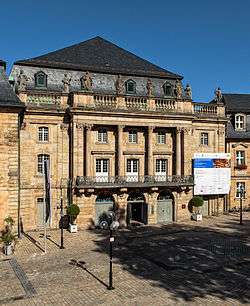Margravial Opera House
| Margravial Opera House Bayreuth | |
|---|---|
| Name as inscribed on the World Heritage List | |
 | |
| Type | Cultural |
| Criteria | i, iv |
| Reference | 1379 |
| UNESCO region | Europe and North America |
| Inscription history | |
| Inscription | 2012 (36th Session) |
The Margravial Opera House (German: Markgräfliches Opernhaus) is a Baroque opera house in the town of Bayreuth, Germany, built between 1744 and 1748. It is one of Europe's few surviving theatres of the period and has been extensively restored. On 30 June 2012 the opera house was inscribed in the UNESCO World Heritage List.[1]
History
It was built according to plans designed by the French architect Joseph Saint-Pierre (ca. 1709 – 1754), court builder of the Hohenzollern margrave Frederick of Brandenburg-Bayreuth and his wife Princess Wilhelmine of Prussia. It was inaugurated on the occasion of the marriage of their daughter Elisabeth Fredericka Sophie with Duke Charles Eugene of Württemberg.
The wooden interior was designed by Giuseppe Galli Bibiena (1696 – 1757) and his son Carlo from Bologna in an Italian Late Baroque style. The box theatre is completely preserved in its original condition, except for the curtain which was taken by Napoleon's troops on their march to the 1812 Russian campaign. The prince box was seldom used by the art-minded margravial couple, who preferred a front-row seat.
Princess Wilhelmine, older sister of the Prussian king Frederick the Great, had established the margravial theatre company in 1737. In the new opera house she participated as a composer of opera works and Singspiele', as well as an actor and director. Today she features in a sound-and-light presentation for tourists. After her death in 1758, performances ceased and the building went into disuse, one reason for its good conservation status.
More than one hundred years later, the stage's great depth of 27 metres (89 ft)[2] attracted the composer Richard Wagner, who in 1872 chose Bayreuth as festival centre and had the Festspielhaus built north of the town. The foundation stone ceremony was held on May 22, Wagner's birthday, and included a performance of Beethoven's Symphony No. 9, directed by the maestro himself.
Parts of the 1994 biopic Farinelli were filmed in the Opera House. The theatre was the site of the annual Bayreuther Osterfestival until 2009. Each September from the year 2000 to 2009, the theatre also hosted the Bayreuth Baroque festival, with performances of early operatic rarities. The 2009 festival included performances of Andrea Bernasconi's festa teatrale, L'Huomo, to a libretto by the Margravine Wilhelmine.
The theatre closed in October 2012 for extensive refurbishment and redevelopment and is not expected to reopen for several years.[2]
References
- ↑ "Margravial Opera House Bayreuth". UNESCO. Retrieved 22 January 2016.
- 1 2 "UNESCO-Weltkulturerbe Markgräfliches Opernhaus" [UNESCO World Heritage Site: Margravial Opera House] (in German). City of Bayreuth: Tourism, Culture and Leisure. Retrieved 22 January 2016.
External links
| Wikimedia Commons has media related to Category:Markgräfliches Opernhaus. |
- Official Information (English)
- Information on the annual Bayreuther Barock Festival held in the opera house
Coordinates: 49°56′40″N 11°34′42″E / 49.944371°N 11.578302°E